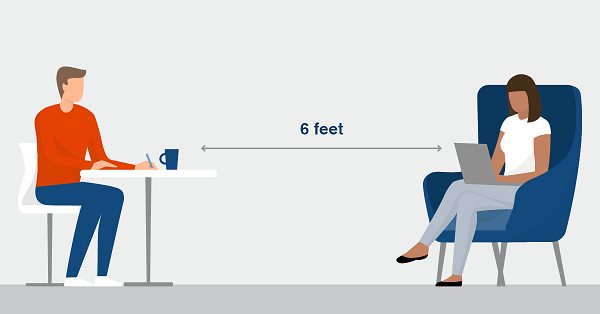
Social distancing: How far is six feet apart?
The ‘six feet of distance’ (which also works out to two metres) rule comes from studies of respiratory physiology. Without a cough or a sneeze, the air we breathe within a distance of three to six feet is called the breathing zone.
It is in that kind of volume of air that one exhales (breathes out) mixes with the air that is already in a room.
If you are standing within three to six feet of a person, you may well inhale some of what the person breathes out. And of course, if someone has the virus and is breathing it out, what you are inhaling within six feet away may microscopically contain the virus.
Are you six feet or two metres apart? Here are a few tips to help you estimate.
Think about the following to know whether you are really practising social distancing...
Six feet in practice
Sofa: A standard three-seat sofa can be up to six feet long, which means that you and the person sitting on the other end of it probably are not far away enough from each other.
Average car: Think of the width of your car when trying to gauge an appropriate distance -- an average large Sedan is a little more than six feet wide.
Dining table: Try imagining you and your friend sitting across from each other at a long, fancy dining table, some of them stretch 6 feet across.
Length full bed: The lengths of full-and twin-size beds are about 6.2 feet from top to bottom.
Door: A door should be relatively easy to find when questioning whether you and your friend should move farther apart. Six feet is a little shorter than the average modern door, which runs from 78 to 80 inches.
Six feet long bathtub: A more relaxing comparison: Some bathtubs are 72 inches long.
Aware habits
Within our own households, we have to essentially do the best to be aware of our habits regarding sneezing and coughing, no matter who we are around.
You should make sure that you and the people around you follow what the World Health Organisation (WHO) calls ‘good respiratory hygiene’.
This means you should cover your mouth and nose with a tissue or crook of the arm when you cough or sneeze, then throw away the tissue immediately.
Wearing a mask in public places, while practising social distancing is a good measure to take.
Wash your hands frequently or sanitise in cases where there is no water. Avoid touching your face, and, if possible, restrict your movements. Stay at home.
E-mail: nanaesi_19@yahoo.co.uk
